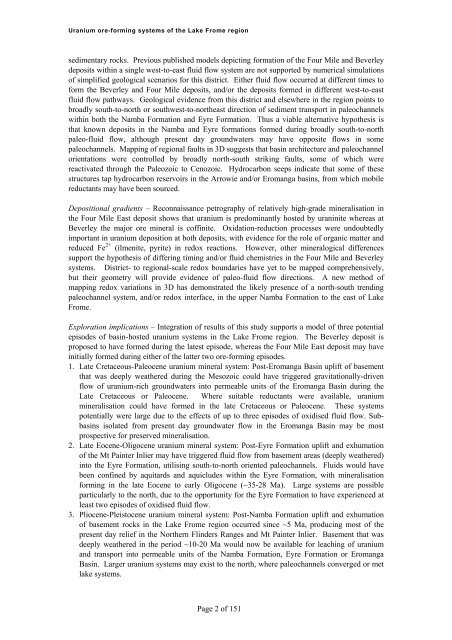Uranium ore-forming systems of the - Geoscience Australia
Uranium ore-forming systems of the - Geoscience Australia
Uranium ore-forming systems of the - Geoscience Australia
You also want an ePaper? Increase the reach of your titles
YUMPU automatically turns print PDFs into web optimized ePapers that Google loves.
<strong>Uranium</strong> <strong>ore</strong>-<strong>forming</strong> <strong>systems</strong> <strong>of</strong> <strong>the</strong> Lake Frome regionsedimentary rocks. Previous published models depicting formation <strong>of</strong> <strong>the</strong> Four Mile and Beverleydeposits within a single west-to-east fluid flow system are not supported by numerical simulations<strong>of</strong> simplified geological scenarios for this district. Ei<strong>the</strong>r fluid flow occurred at different times t<strong>of</strong>orm <strong>the</strong> Beverley and Four Mile deposits, and/or <strong>the</strong> deposits formed in different west-to-eastfluid flow pathways. Geological evidence from this district and elsewhere in <strong>the</strong> region points tobroadly south-to-north or southwest-to-nor<strong>the</strong>ast direction <strong>of</strong> sediment transport in paleochannelswithin both <strong>the</strong> Namba Formation and Eyre Formation. Thus a viable alternative hypo<strong>the</strong>sis isthat known deposits in <strong>the</strong> Namba and Eyre formations formed during broadly south-to-northpaleo-fluid flow, although present day groundwaters may have opposite flows in somepaleochannels. Mapping <strong>of</strong> regional faults in 3D suggests that basin architecture and paleochannelorientations were controlled by broadly north-south striking faults, some <strong>of</strong> which werereactivated through <strong>the</strong> Paleozoic to Cenozoic. Hydrocarbon seeps indicate that some <strong>of</strong> <strong>the</strong>sestructures tap hydrocarbon reservoirs in <strong>the</strong> Arrowie and/or Eromanga basins, from which mobilereductants may have been sourced.Depositional gradients – Reconnaissance petrography <strong>of</strong> relatively high-grade mineralisation in<strong>the</strong> Four Mile East deposit shows that uranium is predominantly hosted by uraninite whereas atBeverley <strong>the</strong> major <strong>ore</strong> mineral is c<strong>of</strong>finite. Oxidation-reduction processes were undoubtedlyimportant in uranium deposition at both deposits, with evidence for <strong>the</strong> role <strong>of</strong> organic matter andreduced Fe 2+ (ilmenite, pyrite) in redox reactions. However, o<strong>the</strong>r mineralogical differencessupport <strong>the</strong> hypo<strong>the</strong>sis <strong>of</strong> differing timing and/or fluid chemistries in <strong>the</strong> Four Mile and Beverley<strong>systems</strong>. District- to regional-scale redox boundaries have yet to be mapped comprehensively,but <strong>the</strong>ir geometry will provide evidence <strong>of</strong> paleo-fluid flow directions. A new method <strong>of</strong>mapping redox variations in 3D has demonstrated <strong>the</strong> likely presence <strong>of</strong> a north-south trendingpaleochannel system, and/or redox interface, in <strong>the</strong> upper Namba Formation to <strong>the</strong> east <strong>of</strong> LakeFrome.Exploration implications – Integration <strong>of</strong> results <strong>of</strong> this study supports a model <strong>of</strong> three potentialepisodes <strong>of</strong> basin-hosted uranium <strong>systems</strong> in <strong>the</strong> Lake Frome region. The Beverley deposit isproposed to have formed during <strong>the</strong> latest episode, whereas <strong>the</strong> Four Mile East deposit may haveinitially formed during ei<strong>the</strong>r <strong>of</strong> <strong>the</strong> latter two <strong>ore</strong>-<strong>forming</strong> episodes.1. Late Cretaceous-Paleocene uranium mineral system: Post-Eromanga Basin uplift <strong>of</strong> basementthat was deeply wea<strong>the</strong>red during <strong>the</strong> Mesozoic could have triggered gravitationally-drivenflow <strong>of</strong> uranium-rich groundwaters into permeable units <strong>of</strong> <strong>the</strong> Eromanga Basin during <strong>the</strong>Late Cretaceous or Paleocene. Where suitable reductants were available, uraniummineralisation could have formed in <strong>the</strong> late Cretaceous or Paleocene. These <strong>systems</strong>potentially were large due to <strong>the</strong> effects <strong>of</strong> up to three episodes <strong>of</strong> oxidised fluid flow. Subbasinsisolated from present day groundwater flow in <strong>the</strong> Eromanga Basin may be mostprospective for preserved mineralisation.2. Late Eocene-Oligocene uranium mineral system: Post-Eyre Formation uplift and exhumation<strong>of</strong> <strong>the</strong> Mt Painter Inlier may have triggered fluid flow from basement areas (deeply wea<strong>the</strong>red)into <strong>the</strong> Eyre Formation, utilising south-to-north oriented paleochannels. Fluids would havebeen confined by aquitards and aquicludes within <strong>the</strong> Eyre Formation, with mineralisation<strong>forming</strong> in <strong>the</strong> late Eocene to early Oligocene (~35-28 Ma). Large <strong>systems</strong> are possibleparticularly to <strong>the</strong> north, due to <strong>the</strong> opportunity for <strong>the</strong> Eyre Formation to have experienced atleast two episodes <strong>of</strong> oxidised fluid flow.3. Pliocene-Pleistocene uranium mineral system: Post-Namba Formation uplift and exhumation<strong>of</strong> basement rocks in <strong>the</strong> Lake Frome region occurred since ~5 Ma, producing most <strong>of</strong> <strong>the</strong>present day relief in <strong>the</strong> Nor<strong>the</strong>rn Flinders Ranges and Mt Painter Inlier. Basement that wasdeeply wea<strong>the</strong>red in <strong>the</strong> period ~10-20 Ma would now be available for leaching <strong>of</strong> uraniumand transport into permeable units <strong>of</strong> <strong>the</strong> Namba Formation, Eyre Formation or EromangaBasin. Larger uranium <strong>systems</strong> may exist to <strong>the</strong> north, where paleochannels converged or metlake <strong>systems</strong>.Page 2 <strong>of</strong> 151
















